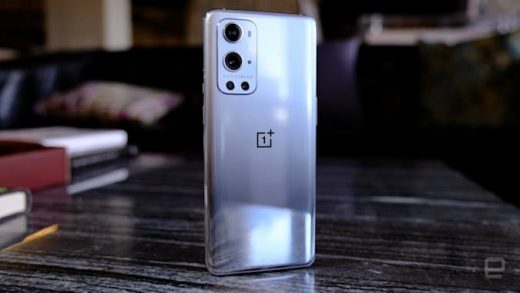OnePlus 9 Pro review: A case against duopolies
OnePlus 9 Pro review: A case against duopolies
The company’s best phone yet is a true flagship, right down to its price tag.

Conventional wisdom — and quite a bit of market data — tells us that when people start shopping for high-end smartphones, they’ll usually wind up with an iPhone or a Samsung Galaxy. With the new OnePlus 9 Pro, though, OnePlus makes a convincing argument for skipping the duopoly and trying something different. That’s because the company managed to build its best smartphone yet, one truly deserving of the flagship label. Its focus on speed, screen quality, and a renewed commitment to photography just might help the brand win over a new legion of fans. It’s just too bad OnePlus’s best phones these days aren’t the deals they used to be.
Configurations
OnePlus made a name for itself by building inexpensive smartphones that could compete with — and undercut — some of the best devices out there. Starting with last year’s OnePlus 8 Pro, however, OnePlus began moving into the same price tiers as its biggest competitors. Now, with the OnePlus 9 Pro, the company is asking people to pay more than ever for its highest-end smartphones. Here’s the breakdown:
9 Pro 5G
88

Pros
- Fantastic display
- First-rate performance
- Much-improved main camera
Cons
- More expensive than ever
- Mediocre telephoto camera
- Limited carrier support for 5G
-
8GB LPDDR5 RAM/128GB storage: $970
-
12GB LPDDR5 RAM/256GB storage: $1,070
In fairness to OnePlus, another new model — the standard OnePlus 9 — was designed to deliver most of the 9 Pro experience at prices starting at $730. We’ll be testing and covering this device separately, but for now, it’s best to think of it as a sort of Fan Edition device — that is, it offers speedy performance and battery life similar to the flagship model, albeit with a less impressive screen and cameras.
If you’re still in leaning towards the 9 Pro, you’ll also have three colors to choose from, none of which are as striking as the finishes we saw last year. Our review unit came in “Morning Mist,” a gleaming silver, but OnePlus will also sell black and matte forest green models through retailers like Amazon, Best Buy and more, as well as through its main carrier partner, T-Mobile.

Hardware and display
The OnePlus 9 Pro has a lot going for it, but I wouldn’t count its design among its strengths. We know the company can make flashy, beautiful hardware — its special-edition Cyberpunk 2077 handset was gorgeously out-there, while a leather-clad concept designed in partnership with McLaren hearkened back to the days when smartphone designs were more adventurous.
Meanwhile, the Pro hasn’t changed much since last year. It’s slightly lighter and thinner, which is always a good thing considering how much time we spend on our phones. Other than that, we’re still looking at pretty standard OnePlus fare: dual speakers, a microSIM slot next to the Warp Charge-compatible USB-C port, and one of their alert sliders above the power button to switch between silent, vibrate and full volume modes, all in a body that’s rated IP68 for water and dust resistance.
So yes, the OnePlus 9 Pro may be somewhat lacking in style, but some of the company’s small changes go a long way in improving the overall experience. For one, gone is the big, center-mounted camera hump that made last year’s 8 Pro wobble when laid on flat surfaces. In its place you’ll find a quad-camera system that juts out considerably less. I’ve also spent years complaining about waterfall displays, or displays that curved around a phone’s face because the sides of my hand usually brush up against something by accident. Turns out, OnePlus has received enough complaints that it did away with the curved look almost completely. The Gorilla Glass protecting the screen still curves slightly around the phone’s facade, but the side of the display stops well before the glass does. Just like that: no more accidental touches, and I’m a happy camper.
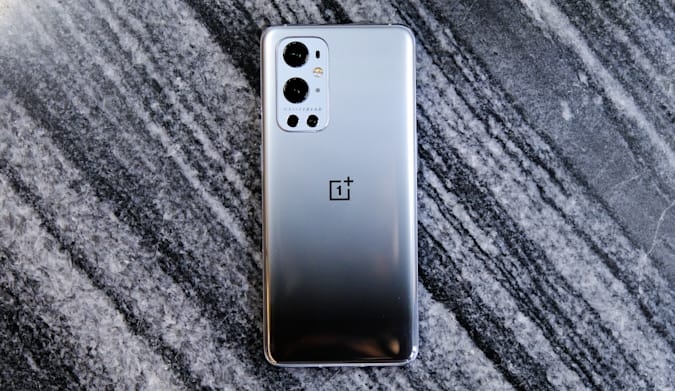
And while we’re talking about the screen, the 6.7-inch, 3 216 x 1,440 AMOLED panel OnePlus went with this year is one of the nicest I’ve seen on a smartphone. (What else would you expect from a display manufactured by Samsung?) That’s partially because its maximum brightness tops out at around 1,300 nits, which makes the 9 Pro a breeze to use under bright sunlight, and because the screen’s expressive colors lend your videos and games a pleasant punchiness. Long story short, the OnePlus 9 Pro’s display is well-suited for outdoor use now that it’s nice out and for lounging around like an inert sloth-person watching anime — both of which are really important use cases to me!
What’s especially important here is that the OnePlus 9 Pro’s screen has a variable refresh rate. At its peak, when you’re playing Fortnite or whipping through websites in Chrome, the screen refreshes at 120Hz for maximum smoothness. But when you’re looking at photos or reading a page of static text, that refresh rate bottoms out at 1Hz. In other words, it refreshes just once a second. This isn’t, strictly speaking, new; phones like the Galaxy Note 20 Ultra and the S21 Ultra have similar dynamic refresh rate tricks. But neither of those screens can go as low as 1Hz, which — in theory, at least — should give the OnePlus 9 Pro a long-term edge in battery life.
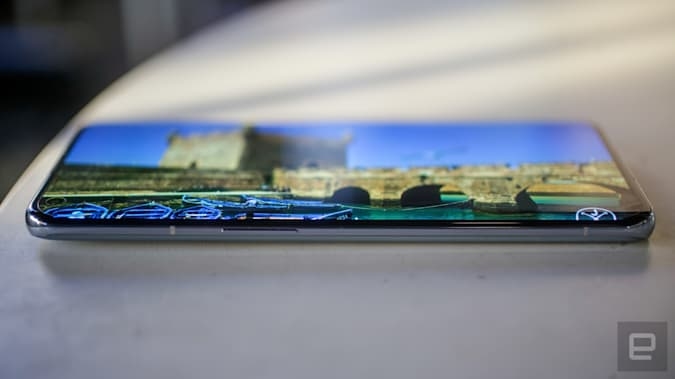
It’s also worth noting that there are also a ton of handy screen settings to fiddle with, like a HyperTouch mode that increases the phone’s screen polling rate. In other words, it makes the touchscreen even more responsive than usual when you’re playing one of the four games the feature works with right now. Theoretically, better screen sensitivity could give you an edge when you’re in the thick of combat, but if you’re a serious gamer trying to make a name for yourself, you’re probably better off using a dedicated controller anyway.
And if more life-like visuals are what you’re after, there’s a motion smoothing mode that gives your videos that sort of real-time soap opera look that, not to mention an ultra high-res video mode that for now only seems to work with… Instagram? Bear in mind, I also have Netflix and HBO Max installed on the 9 Pro, either of which would probably benefit more from AI-enhanced video. Let’s see if OnePlus manages to widen app support over time.
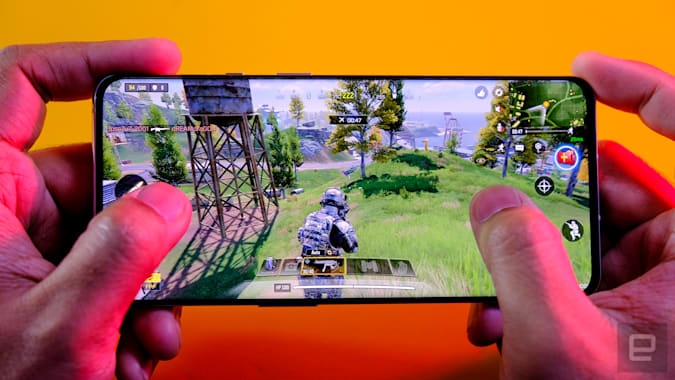
In use
Last year, I wrote that OnePlus as a company is “obsessed with speed,” and that obsession is as strong as ever in the 9 Pro. The sheer responsiveness of the screen plays a major role in how fast the phone feels, and so does the Snapdragon 888 processor ticking away inside. You’re going to be hearing about it a lot this year — it’s the fastest chipset Qualcomm makes right now, and when it’s paired with either 8GB or 12GB of LPDDR5 RAM like it is here, there’s very little it can’t handle. In fact, I say that, but I haven’t found anything that managed to throw the OnePlus 9 Pro for a loop for the week or so I’ve been testing it. It’s just that fast — a trait it’ll probably share with every other thousand-dollar phone released this year.
As usual, there’s a lot to like about OnePlus’s custom OxygenOS build of Android 11. For the most part, it tends to behave like stock Android, which I will always prefer to the overwrought software smartphone makers tend to prefer. Thankfully, the many add-ons built into OxygenOS do more than just give the 9 Pro a more distinct identity — they’re damned useful, too.
Tired of the standard date and time on your always-on display? Why not use an artsy, thermometer-looking thing instead, so you know in excruciating detail how often you pick up and unlock your phone? While you’re being more mindful of mindfulness, OnePlus’s Zen mode returns to lock down your phone for 20 minutes at a time so you can just be for a bit. And since we’re this close to safely being able to go out and be a part of the world again, OxygenOS’s built-in step counter and parking spot reminders are nice to have just a swipe away from the home screen.
Gallery: OnePlus 9 Pro review photos | 11 Photos
Of course, none of this would matter if the OnePlus 9 Pro had lousy battery life, and I’m mostly pleased to report that the phone’s 4,500mAh dual batteries have performed on par with other premium phones released this year. With the screen cranked up to its maximum resolution, I’ve routinely been able to get through a full working day with the 9 Pro without much trouble, though heavy days pretty much guarantee you’ll need a charge by the evening. Do yourself a favor and leave this screen on Full HD instead — most people will never see the difference, and it means the 9 Pro can last well into the following day on a single charge. Then again, the OnePlus 9 Pro comes with one of the company’s Warp Charge 65T power bricks, and in my experience the phone’s dual batteries can go from bone dry to just about full in 30 minutes. With that kind of charging speed available, even days of frantic use can be offset by very quick trips to a power outlet.
There’s just one caveat I’d add: These days, I still spend far more time at home on WiFi than I would in a more normal year, so your experience might be a little different if you routinely go out and jump on 5G connections. And speaking of 5G, it’s worth noting that the 9 Pro’s carrier support seems a little scattershot at the moment. As mentioned earlier, T-Mobile has partnered with OnePlus to sell this new slate of smartphones, so it’s no surprise they play nice with the carrier’s sub-6 5G network. The OnePlus 9 Pro technically supports the non-mmWave parts of Verizon’s 5G network, but it hasn’t been fully certified to run on them yet — for now, LTE support is the best you’ll get. (Full disclosure: Verizon is Engadget’s parent company, but has no control over what we publish.) Meanwhile, AT&T customers are arguably the worst off, as OnePlus hasn’t announced any kind of support for AT&T 5G in either of its new smartphones.

Cameras
If there’s one change that’s really worth paying attention to this year, it’s the OnePlus 9 Pro’s cameras. If you’ve never used a OnePlus phone before, you should know that their cameras were never bad, but they’ve never come close to being top-of-the-line. This year, OnePlus is trying to change that, not just with clever hardware choices, but with a multi-year partnership with Hasselblad — one of the world’s most well-regarded camera brands.
OnePlus says that over the next three years it will work closely with Hasselblad on developing new custom camera hardware. So far, though, the fruits of that partnership are pretty limited. Basically, OnePlus tapped the Hasselblad brain trust to make sure the colors in the photos these cameras take are as true to life as possible. Of course, it doesn’t hurt that OnePlus is using much better camera sensors than usual this year.
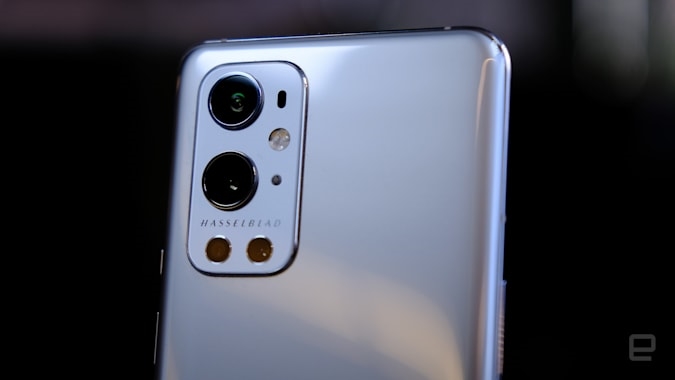
You’ll spend most of the time with the 48-megapixel main camera, which uses a custom-made Sony sensor. What can I say? It produces some gorgeous photos. Hasselblad’s color tuning really does feel true to life, though some people, myself included, will prefer Samsung’s approach. Even so, it produces richly detailed 12MP stills with a little help from the tiny monochrome camera, and its wide f/1.8 aperture plus an improved NightScape mode means it performs really well in the dark, too.
The ultra-wide camera is no slouch either — it uses a 50-megapixel sensor to capture surprisingly detailed stills, and OnePlus added what it calls a “freeform” lens to help reduce image distortion around the edges without having to rely solely on software. It… helps to an extent, but the distortion is definitely still there. Even so the relative richness of the images this camera takes usually makes up for it.
If this setup has a weak point, it’s the 8-megapixel telephoto camera. I mean, of course it is. It has nothing to do with the fact that it shoots at the lowest resolution of the three main cameras or the fact that its 3.3x optical zoom seems paltry compared to the 10x optical zoom you get from phones like the Galaxy S21 Ultra. More than anything, it’s this camera’s tendency to produce overexposed images in bright situations. The results are never awful per se, but they’re not nearly as nice as what the other cameras can deliver.
Gallery: OnePlus 9 Pro camera sample photos | 22 Photos
Still, serious smartphone photographers are going to get a kick out of these options. In addition to the usual stuff like ISO, shutter speed and focus controls, you can throw up a histogram, swap between different color profiles, and even turn on focus peaking just to make sure your subjects are tack-sharp. Overkill? Maybe, but I’m not complaining.
There are just a few other things to note on the camera front. As much as I hate admitting it, I do take a lot of selfies, and even with face-tracking turned on, the OnePlus 9 Pro’s 16-megapixel front camera always makes my face look soft — and I mean soft in the not-terribly-detailed way, not the round-cheeks-and-pillowy-lips way. There’s also a tilt-shift mode built directly into the camera app which is… fine, I guess? The effect can be pretty convincing, but I’m not sure why OnePlus bothered to include it in the first place.
Oh, and if you’re more of a video person, the 9 Pro performed much better than I would have expected. You can shoot at resolutions as high as 8K at 30fps, and while you probably don’t have a screen to play that file back in its full glory, the resulting footage offers enough detail, vibrant color and dynamic range to give the Galaxy S21 Ultra a run for its money.
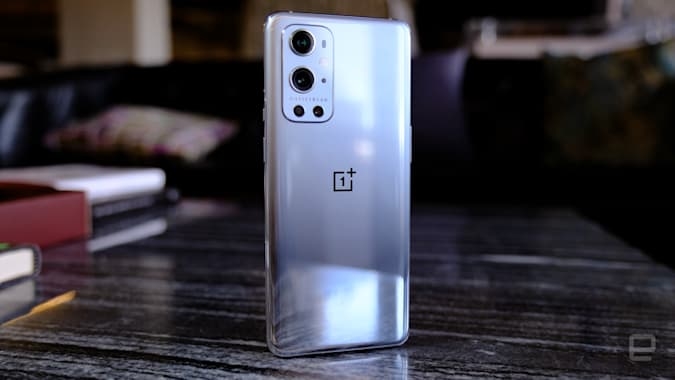
Wrap-up
This is, without question, the best device OnePlus has ever made. If you’ve been thinking about splurging on a new smartphone, the 9 Pro deserves your consideration — it’s a true flagship, with the price to match. The only thing keeping me from recommending more strongly is its competition. You can pretty easily find a Galaxy S21 Ultra for around the same price, and it comes with a much more flexible camera system, an extended software support window and a more ambitious set of features. (I’d probably stick with one of those myself.) Even so, the OnePlus 9 Pro is, at the very least, extremely competent at everything it sets out to do, and well worth you’re time if you value the sensation of speed over anything else.
(10)

